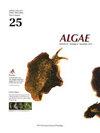海藻幼苗生产的最新进展:桉树和其他有价值的海藻综述
IF 2.4
3区 生物学
Q1 MARINE & FRESHWATER BIOLOGY
引用次数: 6
摘要
现代海藻养殖在很大程度上依赖于自然床上的幼苗或以前收获的无性扦插。然而,这种养殖方式也存在一些缺点,如种子的生理变异和遗传变异的减少,从而降低了海藻的生长速度、卡拉胶产量和凝胶强度。需要一种可持续的、可扩展的、能生产大量高质量幼苗的新方法来支持海藻养殖业。近年来,组织培养和微繁技术在拟真金藻生产中的应用,在增加种子供应和短时间内长出大量均匀的幼苗方面取得了可喜的成果。几种海藻已经在实验室中通过直接再生、愈伤组织培养和原生质体培养成功地培养和再生成新植株。在培养基中使用生物刺激剂和植物生长调节剂可以进一步提高幼苗质量。微繁苗比常规栽培苗生长快,生化性能好。在转移到陆基生长系统或海洋网进行养殖之前,建议组织培养的幼苗进行适应过程,以提高其存活率。需要定期监测,以防止在养殖过程中出现病虫害和草食性鱼类和海龟的放牧。本综述讨论了生产拟真藻和其他有价值的海藻养殖材料的最新技术,强调了微繁殖的效率以及从实验室培养到陆基或远洋生长系统培养的过渡,以阐明可持续海藻生产的最佳条件。本文章由计算机程序翻译,如有差异,请以英文原文为准。
Recent advances in seaweed seedling production: a review of eucheumatoids and other valuable seaweeds
Modern seaweed farming relies heavily on seedlings from natural beds or vegetative cuttings from previous harvests. However, this farming method has some disadvantages, such as physiological variation in the seed stock and decreased genetic variability, which reduces the growth rate, carrageenan yield, and gel strength of the seaweeds. A new method of seedling production that is sustainable, scalable, and produces a large number of high-quality plantlets is needed to support the seaweed farming industry. Recent use of tissue culture and micropropagation techniques in eucheumatoid seaweed production has yielded promising results in increasing seed supply and growing uniform seedlings in large numbers in a shorter time. Several seaweed species have been successfully cultured and regenerated into new plantlets in laboratories using direct regeneration, callus culture, and protoplast culture. The use of biostimulants and plant growth regulators in culture media increases the seedling quality even further. Seedlings produced by micropropagation grew faster and had better biochemical properties than conventionally cultivated seedlings. Before being transferred to a land-based grow-out system or ocean nets for farming, tissue-cultured seedlings were recommended to undergo an acclimatization process to increase their survival rate. Regular monitoring is needed to prevent disease and pest infestations and grazing by herbivorous fish and turtles during the farming process. The current review discusses recent techniques for producing eucheumatoid and other valuable seaweed farming materials, emphasizing the efficiency of micropropagation and the transition from laboratory culture to cultivation in land-based or open-sea grow-out systems to elucidate optimal conditions for sustainable seaweed production.
求助全文
通过发布文献求助,成功后即可免费获取论文全文。
去求助
来源期刊

Algae
PLANT SCIENCES-
CiteScore
5.10
自引率
25.00%
发文量
18
期刊介绍:
ALGAE is published by the Korean Society of Phycology and provides prompt publication of original works on phycology. ALGAE publishes articles on all aspects of phylogenetics and taxonomy, ecology and population biology, physiology and biochemistry, cell and molecular biology, and biotechnology and applied phycology. Checklists or equivalent manu-scripts may be considered for publication only if they contribute original information on taxonomy (e.g., new combinations), ecology or biogeography of more than just local relevance. Contributions may take the form of Original Research Articles, Research Notes, Review Articles and Book Reviews.
 求助内容:
求助内容: 应助结果提醒方式:
应助结果提醒方式:


